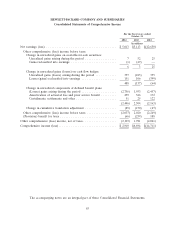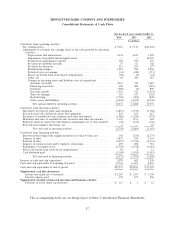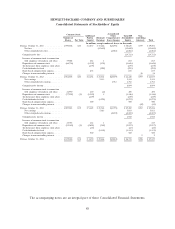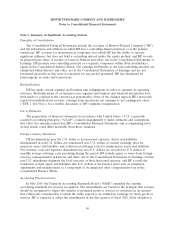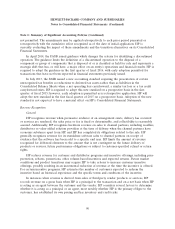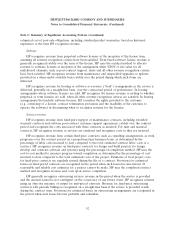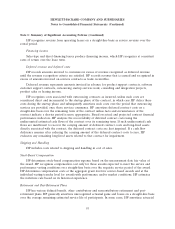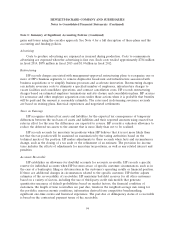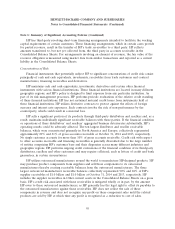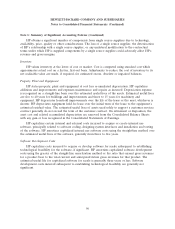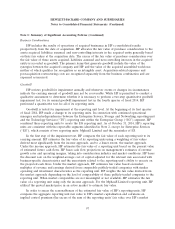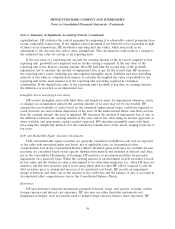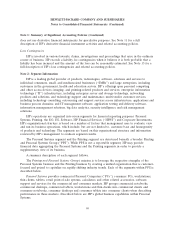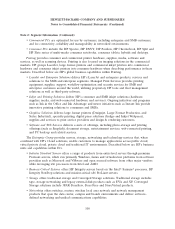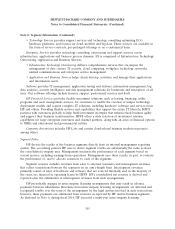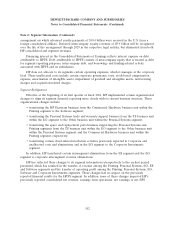HP 2014 Annual Report Download - page 103
Download and view the complete annual report
Please find page 103 of the 2014 HP annual report below. You can navigate through the pages in the report by either clicking on the pages listed below, or by using the keyword search tool below to find specific information within the annual report.HEWLETT-PACKARD COMPANY AND SUBSIDIARIES
Notes to Consolidated Financial Statements (Continued)
Note 1: Summary of Significant Accounting Policies (Continued)
HP has third-party revolving short-term financing arrangements intended to facilitate the working
capital requirements of certain customers. These financing arrangements, which in certain cases provide
for partial recourse, result in the transfer of HP’s trade receivables to a third party. HP reflects
amounts transferred to, but not yet collected from, the third party in accounts receivable in the
Consolidated Balance Sheets. For arrangements involving an element of recourse, the fair value of the
recourse obligation is measured using market data from similar transactions and reported as a current
liability in the Consolidated Balance Sheets.
Concentrations of Risk
Financial instruments that potentially subject HP to significant concentrations of credit risk consist
principally of cash and cash equivalents, investments, receivables from trade customers and contract
manufacturers, financing receivables and derivatives.
HP maintains cash and cash equivalents, investments, derivatives and certain other financial
instruments with various financial institutions. These financial institutions are located in many different
geographic regions, and HP’s policy is designed to limit exposure from any particular institution. As
part of its risk management processes, HP performs periodic evaluations of the relative credit standing
of these financial institutions. HP has not sustained material credit losses from instruments held at
these financial institutions. HP utilizes derivative contracts to protect against the effects of foreign
currency and interest rate exposures. Such contracts involve the risk of non-performance by the
counterparty, which could result in a material loss.
HP sells a significant portion of its products through third-party distributors and resellers and, as a
result, maintains individually significant receivable balances with these parties. If the financial condition
or operations of these distributors’ and resellers’ aggregated business deteriorates substantially, HP’s
operating results could be adversely affected. The ten largest distributor and reseller receivable
balances, which were concentrated primarily in North America and Europe, collectively represented
approximately 20% and 21% of gross accounts receivable at October 31, 2014 and 2013, respectively.
No single customer accounts for more than 10% of gross accounts receivable. Credit risk with respect
to other accounts receivable and financing receivables is generally diversified due to the large number
of entities comprising HP’s customer base and their dispersion across many different industries and
geographic regions. HP performs ongoing credit evaluations of the financial condition of its third-party
distributors, resellers and other customers and may require collateral, such as letters of credit and bank
guarantees, in certain circumstances.
HP utilizes outsourced manufacturers around the world to manufacture HP-designed products. HP
may purchase product components from suppliers and sell those components to its outsourced
manufacturers thereby creating receivable balances from the outsourced manufacturers. The three
largest outsourced manufacturer receivable balances collectively represented 90% and 82% of HP’s
supplier receivables of $1.0 billion and $1.0 billion at October 31, 2014 and 2013, respectively. HP
includes the supplier receivables in Other current assets in the Consolidated Balance Sheets on a gross
basis. HP’s credit risk associated with these receivables is mitigated wholly or in part, by the amount
HP owes to these outsourced manufacturers, as HP generally has the legal right to offset its payables to
the outsourced manufacturers against these receivables. HP does not reflect the sale of these
components in revenue and does not recognize any profit on these component sales until the related
products are sold by HP, at which time any profit is recognized as a reduction to cost of sales.
95


